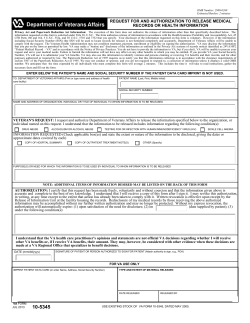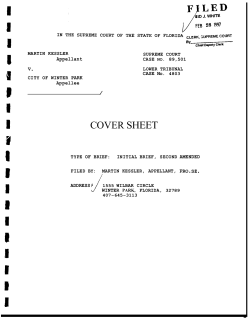
Primary Elec on June 3, 2014
Primary Elec on Ì June 3, 2014 Press Date: March 15, 2014 The League of Women Voters of California Educa on Fund (LWVCEF), a 501(c)(3) nonpar san organiza on, encourages informed and ac ve par cipa on in government and works to increase understanding of major public policy issues. The LWVCEF does not support or oppose candidates, poli cal par es, or ballot measures. The Pros & Cons is a nonpar san explana on of state proposi ons, with suppor ng and opposing arguments. The arguments come from many sources and are not limited to those presented in the Official Voter Informa on Guide. The LWVCEF does not judge the merits of the arguments or guarantee their validity. The LWVCEF grants permission for the Pros & Cons to be reproduced. This publica on is available online at CAvotes.org. At this “Top-Two” primary elec on, California voters will choose among all candidates for state and congressional elec ve offices, regardless of party preference. The two candidates in each race who win the most votes will advance to the November general elec on—regardless of party preference, and even if one of them has received a majority of the votes for that office. California voters will also decide on two state proposi ons, which are explained in this Pros & Cons. Both proposi ons were put on the ballot by the state Legislature. Only proposi ons proposed by the Legislature may now appear on the June primary ballot; all ini a ve measures will appear on the November general elec on ballot. Visit SmartVoter.org® to see everything on your ballot, find your polling place, and get unbiased informa on on all your vo ng choices. How to Evaluate Ballot Proposi ons ÌExamine what the measure seeks to accomplish. Do you agree with those goals? Is the measure consistent with your ideas about government? Do you think the proposed changes will make things be er? ÌWho are the real sponsors and opponents of the measure? Check where the money is coming from on the Voter’s Edge website: votersedge.org/california-elec on-voters-guide-to-ballot-measures-and-candidates (Webpage is expected to be available April 1, 2014.) League of Women Voters of California Educa on Fund 1107 9th Street, Suite 300 Sacramento, CA 95814 916.442.7215 Ì 888.870.VOTE ÌIs the measure wri en well? Will it create conflicts in law that may require court resolu on or interpreta on? Is it “good government,” or will it cause more problems than it will resolve? ÌDoes the measure create its own revenue source? Does it earmark, restrict or obligate government revenues? If so, weigh the benefit of securing funding for this measure against the cost of reducing overall flexibility in the budget. ÌDoes the measure mandate a government program or service without addressing how it will be funded? ÌDoes the measure deal with one issue that can be easily decided by a YES or NO vote? Or, is it a complex issue that should be thoroughly examined in the legisla ve arena? ÌIf the measure amends the Cons tu on, consider whether it really belongs in the Cons tu on. Would a statute accomplish the same purpose? All cons tu onal amendments require voter approval; what we put into the Cons tu on would have to come back to the ballot to be changed. Ì Be wary of distor on tac cs and commercials that rely on image but tell nothing of substance about the measure. Beware of half truths. © 2014 League of Women Voters of California Educa on Fund Page 1 Primary Elec on Ì June 3, 2014 Proposi on 41 LegislaƟve Bond Act Veterans Housing and Homeless Preven on Bond Act of 2014. THE QUESTION: Should California sell $600 million in new general obliga on bonds to fund affordable mul family housing for low-income veterans? THE SITUATION California’s veterans housing programs (“Cal-Vet”) have existed since 1921, and been extended 27 mes; more than 420,000 veterans have par cipated. California general obliga on bonds are sold to investors and the proceeds used to buy homes for eligible veterans, who make monthly payments to the state. These monies are used to repay the bondholders, so there has been no cost to California taxpayers. In 2008, voters approved an addi onal $900 million in bonds to replenish funding for the Cal-Vet program. Since 2000, the number of veterans using the Cal-Vet program has declined significantly for various reasons, including changes in veterans’ housing needs. THE PROPOSAL $600 million worth of bonds would be redirected from the amount approved in 2008, and sold to fund affordable mul family housing, such as apartment complexes, for lowincome veterans. These new bonds would be repaid by taxpayers rather than by the veterans involved. California would provide local governments and nonprofit and private developers with par al financing assistance, such as low-interest loans. Housing built with these funds would be rented to low-income veterans—that is, those earning less than 80% of the local average family income (on average across the state, this means a single veteran earning less than $38,000). These units would be “affordable,” meaning veterans’ rent payments cannot exceed 30% of the income limit for the program. An accompanying state law would mandate priority for projects (including suppor ve housing) for veterans homeless or at risk of becoming homeless. In par cular, at least one-half of the funds would be used for housing for extremely low-income veterans, defined as those earning less than 30% of the local average family income (on average across the state, this means a veteran earning less than $14,000 per year). The Legislature could make future changes to improve the program, and the state would publish an annual program evalua on. FISCAL EFFECTS The $600 million of general obliga on bonds would be repaid using general tax revenues. The cost of these bonds would depend on their interest rates and the repayment period. Assuming that (i) the interest rate averages 5%, and (ii) the bonds would be repaid over a ten-year period, the bond repayment cost would average about $50 million annually for 15 years, or a total of $750 million. Up to $30 million of the bond funds could be used to cover the costs of administering the program. SUPPORTERS SAY Ì This is a fiscally responsible proposi on that will help thousands of homeless California veterans get a roof over their heads. Ì By using previously approved but unsold bond funds, Proposi on 41 doesn’t create new taxes or add new debt to California. OPPONENTS SAY Ì This program will be paid for by the taxpayers instead of by the veterans who paid for it under the original Cal-Vet program. Ì If the funding does not go directly to the intended beneficiaries, there is risk of possible mismanagement and waste. FOR MORE INFORMATION Supporters: Coali on for Veterans Housing www.yesonprop41forvets.org E-mail: info@yesonprop41forvets.org Opponents: Gary Wesley, e-mail: gary.wesley@yahoo.com (Gary Wesley, a northern California a orney, wrote the opposing argument as an individual. At press me, there is no known campaign opposing this Proposi on.) Choosing YES or NO on a Proposi on Want to learn more about bonds? A YES vote means that you approve of the change a proposi on would make, and a NO vote means that you want to leave things as they are now. © 2014 League of Women Voters of California Educa on Fund See Page 4 for more informa on. Page 2 Primary Elec on Ì June 3, 2014 Proposi on 42 LegislaƟve ConsƟtuƟonal Amendment Public Records. Open Mee ngs. State Reimbursement to Local Agencies. THE QUESTION: Should the state Cons tu on be amended to require local governments to comply with state public-access laws, and to eliminate the requirement that the state reimburse local governments for the costs of such compliance? THE SITUATION FISCAL EFFECTS State public-access laws include the Ralph M. Brown Act, which requires governmental bodies to provide public no ce of agenda items and to hold open mee ngs, and the Public Records Act, which requires governmental bodies to provide copies of government documents to the public upon request. Local governments must comply with these laws, although that requirement is not spelled out in the state Cons tu on. Proposi on 42 would result in savings to the state, and comparable revenue losses to local governments, in the likely amount of tens of millions of dollars a year. There could be further costs to local governments, poten ally in the tens of millions of dollars a year, if the state imposes addi onal such mandates on them. Under the Cons tu on, the state is required to reimburse local governments for the costs of complying with these laws and any other laws mandated by the Legislature. However, the state no longer has to reimburse local governments for their costs of carrying out the Brown Act, due to the passage of Proposi on 30 in 2012. A sec on of Proposi on 30 eliminated that requirement from the Cons tu on. The state s ll is required to reimburse local governments for the costs of carrying out the Public Records Act. The state owes local governments a large sum of money for carrying out the Public Records Act, es mated to be in the tens of millions of dollars annually. Because of this, the Legislature considered making the requirements of the Public Records Act op onal for local governments, but instead voted to put Proposi on 42 on the ballot. THE PROPOSAL Proposi on 42 would (i) amend the Cons tu on to specifically require that local governmental bodies must comply with the Brown Act and the Public Records Act, and (ii) eliminate the requirement that the state reimburse local governments for the costs of complying with these acts and any similar acts that might be passed by the Legislature in the future. SUPPORTERS SAY Ì Proposi on 42 will cement in the Cons tu on the public’s right to know what the government is doing and how it is doing it. Ì Proposi on 42 will clarify that local government agencies, and not the state, are responsible for the costs of compliance with the public-access laws. OPPONENTS SAY Ì Local governments can’t be relied upon to comply fully with these laws if they must bear the costs themselves. Ì It’s wrong for the state to impose the costs of complying with these laws on local governments. The state should con nue to pay those costs. FOR MORE INFORMATION Supporters: First Amendment Coali on www.cnpa.com/prop42 E-mail: pscheer@firstamendmentcoali on.org Opponents: Gary Wesley, e-mail: gary.wesley@yahoo.com (Gary Wesley, a northern California a orney, wrote the opposing argument as an individual. At press me, there is no known campaign opposing this Proposi on.) Looking for more informa on on the proposi ons? Ì Official Voter Informa on Guide • voterguide.sos.ca.gov Read nonpar san analysis, arguments for and against, and even the full text of the proposed law. Ì Voter’s Edge • votersedge.org/california-elec on-voters-guide-to-ballot-measures-and-candidates Learn more about the supporters and opponents, and find out who is giving money to the YES and NO campaigns. (Webpage is expected to be available April 1, 2014.) Ì SmartVoter.org • Nonpar san Elec on Informa on at SmartVoter.org Type in your address for comprehensive informa on about everything on your ballot. © 2014 League of Women Voters of California Educa on Fund Page 3 Primary Elec on Ì June 3, 2014 About Bonds In light of the bond on the ballot in this elec on, we are providing background informa on regarding the state’s current bond debt, as well as the impact that approval of Proposi on 41 could have within the framework of these state obliga ons and the costs of paying them off over me. What Are Bonds? Bonds are a form of long-term borrowing that the state uses to raise money for infrastructure projects. The state sells bonds to investors and agrees to repay the investors, with interest, according to a specified schedule. Answers to your ques ons about vo ng and the Top-Two primary Visit our website, CAvotes.org, for more informa on about the ballot measures, answers to your ques ons about vo ng, and a wealth of informa on on government and public policy. You can see a list of local Leagues in your community, many of which provide ballot measure speakers and candidate forums. We encourage you to sign up and become a member, and to donate or volunteer. Primary Elec on Ì Tuesday, June 3, 2014 Polls open 7:00 a.m. to 8:00 p.m. May 19 Last day to register to vote May 27 Last day to request a Vote-by-Mail Ballot Why Are Bonds Used? Projects such as roads, educa onal facili es, prisons, parks, office buildings, and housing for veterans involve large dollar costs, and are used over many years. The use of bonds helps to fund the ini al large dollar costs, which would be hard to fund out of day-to-day opera ng revenues. Also, the repayment of these bonds over me means that future taxpayers who benefit from the facili es will help to pay for them. What Types of Bonds Does the State Sell? General Obliga on Bonds are the most significant type of bonds and are largely repaid from the state’s unrestricted general tax revenues. These bonds have to be approved by the voters, and their repayment is effec vely guaranteed by the state. The bonds proposed in Proposi on 41 are general obliga on bonds. There are also Revenue Bonds, repaid from a designated revenue stream—such as bridge tolls—and Lease-Revenue Bonds, repaid from lease payments by state agencies using the leased facili es. Neither type requires voter approval, nor is their repayment guaranteed by the state. What Are the Direct Costs of Bond Financing? The state must repay the principal of the bonds over me to the investors un l the bonds are fully paid off, plus annual interest costs. The interest cost of repaying bonds depends primarily on the current interest rate and the me period over which the bonds have to be repaid. It’s expected that the bonds proposed by Proposi on 41 would be sold over a 30-year period (similar to how homeowners pay off their 30-year home mortgages) at an expected interest rate of 5%. Amount of General Fund Debt. The state currently has about $85 billion of infrastructure bonds outstanding, almost 90% of which are general obliga on bonds. In addi on, about $33 billion of infrastructure bonds have been approved by the voters and are expected to be sold in the coming years as addi onal projects need funding. From now un l 2020, the annual bond repayments, both principal and interest, are expected to rise from over $5 billion to over $7 billion. This Elec on’s Impact on the Debt Servicing. One indicator of the state’s debt burden is the por on of the state’s annual general revenues that must be set aside for debt-service payments. The current amount of the state’s debt is rela vely high in propor on to its unrestricted general revenue. Proposi on 41 is reques ng approval of $600 million of general obliga on bonds to fund mul family housing and services for low-income veterans. This measure, if approved, would increase the amount of the state’s debt, and its annual debtservicing burden, only very minimally. © 2014 League of Women Voters of California Educa on Fund Page 4 Primary Elec on Ì June 3, 2014
© Copyright 2025











